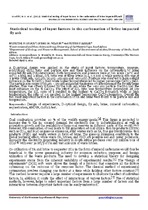| dc.contributor.author | Muriithi, Grace | |
| dc.contributor.author | Gitari, Wilson | |
| dc.contributor.author | Petrik, Leslie | |
| dc.date.accessioned | 2013-10-16T14:20:58Z | |
| dc.date.available | 2013-10-16T14:20:58Z | |
| dc.date.issued | 2012 | |
| dc.identifier.citation | Muriithi, N.G., Gitari, M.W. & Petrik, F.L. (2012). Statistical testing of input factors in the carbonation of brine impacted fly ash. Journal of Environmental Science and Health, Part A. 47:245-259 | en_US |
| dc.identifier.issn | 1093-4529 | |
| dc.identifier.uri | http://hdl.handle.net/10566/764 | |
| dc.description.abstract | A D-optimal design was applied in the study of input factors: temperature, pressure, solid/liquid (S/L) ratio and particle size and
their influence on the carbonation of brine impacted fly ash (FA) determined. Both temperature and pressure were at two levels (30◦C
and 90◦C; 1 Mpa and 4 Mpa), S/L ratio was at three levels (0.1, 0.5 and 1) while particle size was at 4 levels (bulk ash, <20 μm,
20 μm −150 μmand >150 μm). Pressure was observed to have a slight influence on the % CaCO3 yield while higher temperatures led
to higher percentage CaCO3 yield. The particle size range of 20 μm – 150 μm enhanced the degree of carbonation of the fly ash/brine
slurries. This was closely followed by the bulk ash while the >150 μm particle fraction had the least influence on the % CaCO3. The
effect of S/L ratio was temperature dependent. At low temperature, the S/L ratio of 1 resulted in the highest % CaCO3 formation
while at high temperature, the ratio of 0.5 resulted in the highest percentage CaCO3 formation. Overall the two most important
factors in the carbonation of FA and brine were found to be particle size and temperature. | en_US |
| dc.language.iso | en | en_US |
| dc.publisher | Taylor & Francis | en_US |
| dc.rights | This is the author postprint version of an article by Taylor & Francis. The file may be freely used, provided that acknowledgement of the source is given. | |
| dc.source.uri | http://dx.doi.org/10.1080/10934529.2012.640898 | |
| dc.subject | Design of experiments | en_US |
| dc.subject | D-optimal design | en_US |
| dc.subject | Fly ash | en_US |
| dc.subject | Brine | en_US |
| dc.subject | Mineral carbonation | en_US |
| dc.subject | Sequestration | en_US |
| dc.subject | ANOVA | en_US |
| dc.subject | Chittick test | en_US |
| dc.title | Statistical testing of input factors in the carbonation of brine impacted fly ash | en_US |
| dc.type | Article | en_US |
| dc.privacy.showsubmitter | false | |
| dc.status.ispeerreviewed | true | |
| dc.description.accreditation | Web of Science | en_US |

